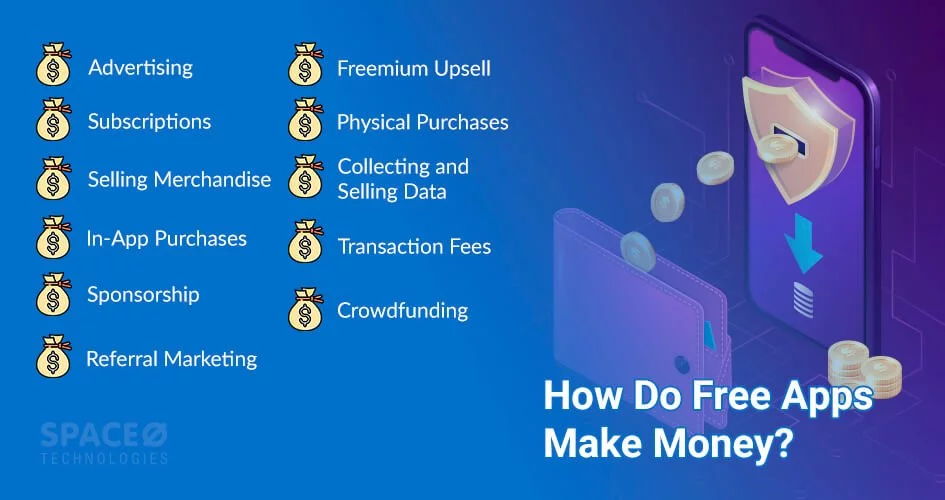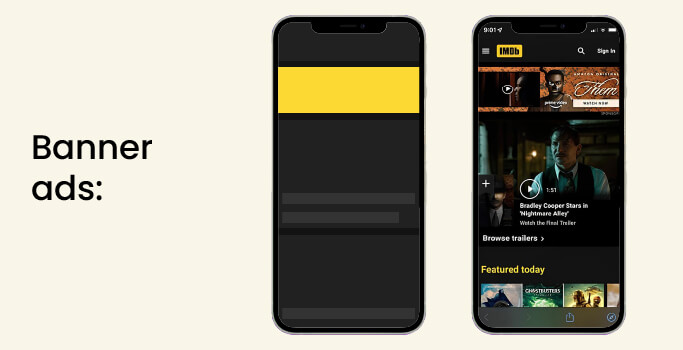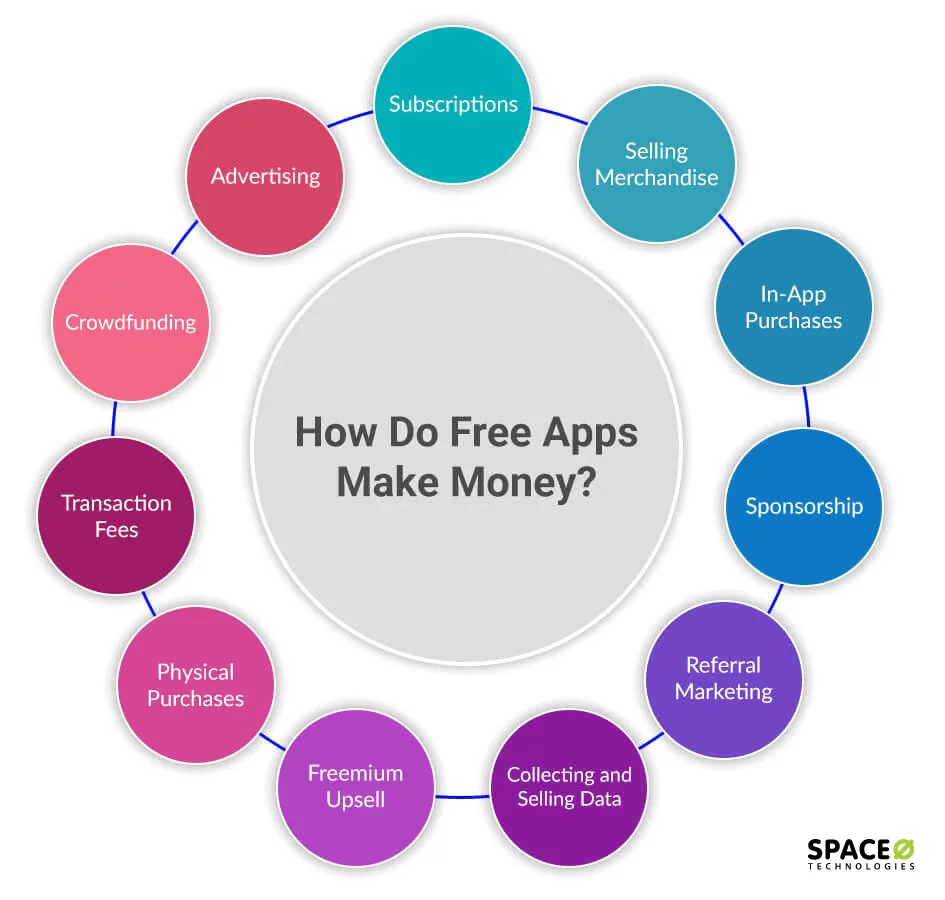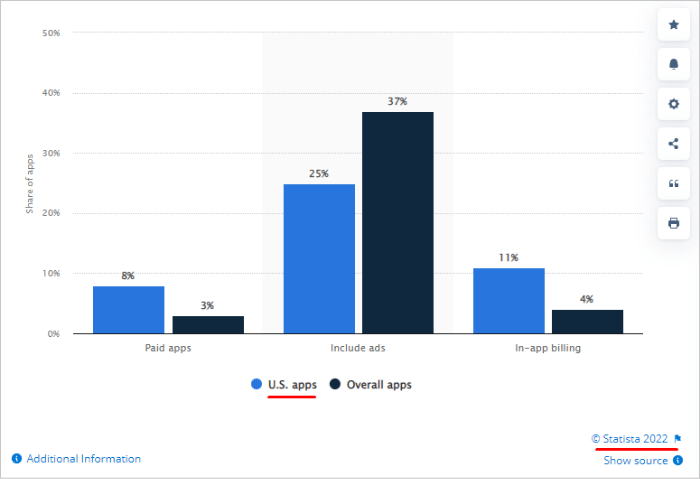- Leverage core monetization strategies like advertising, subscriptions, selling merchandise, in-app purchases, sponsorship, and affiliate or referral marketing, to generate income.
- Generate income from user data while maintaining privacy compliance, creating a balance between making money and maintaining user trust.
Key Takeaways
If you want to create a custom app and want to know how to make money out of it,
this blog is for you.
The mobile app industry is projected to reach $777.4 billion by 2032. As the free mobile apps market has always outnumbered the paid ones in terms of profits and download numbers. This is a common question before developing an app – how do free apps make money?
Before answering this question, let’s look at a few stats about Android and iOS mobile apps.
As of 2023, 97% of apps in the Google Play app store were available for free.
Based on these statistics you should know the majority of the apps are free on Play Store and App Store.
But, how do app businesses earn money with free applications?
Let’s learn the complete monetization strategy by going through this guide.
Table of Contents
A Quick Overview of Freemium Apps Vs. Paid Apps Market
1. 82% of the mobile apps available through Amazon apps are free, and only 18% of mobile apps are paid.
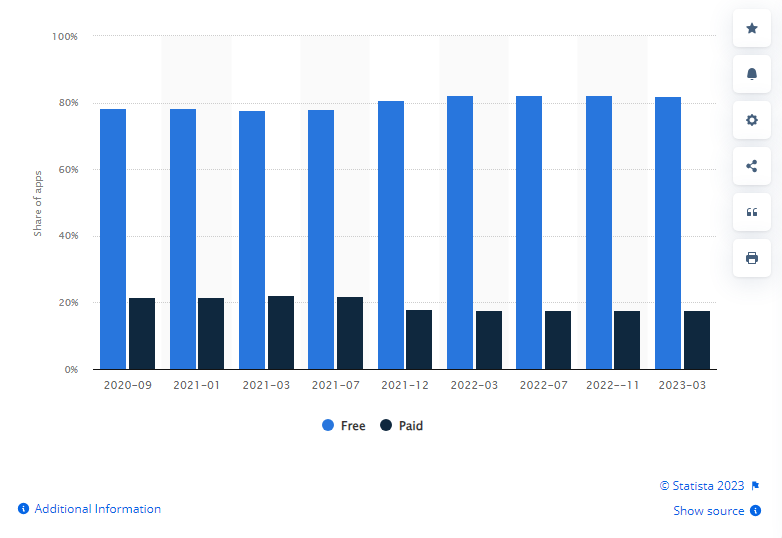
2. In 2021, users spent 6 billion US dollars on the top subscription apps through the App Store, compared to 2.5 billion US dollars in the Google Play Store.
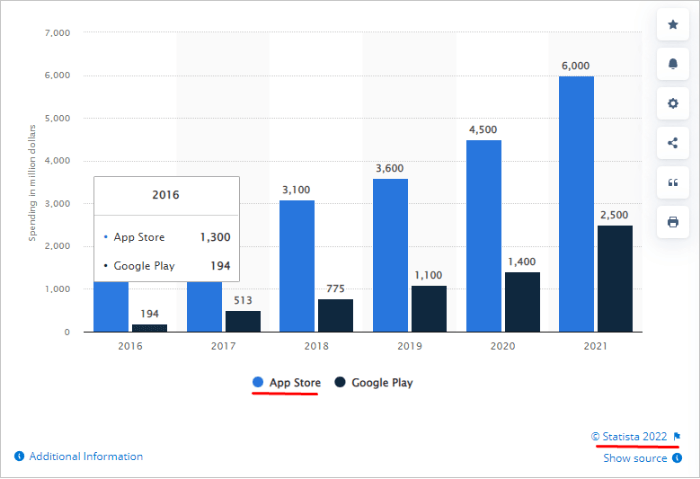
Want to Create an App for Your Business?
Our experienced app developers have created more than 4400 mobile apps. Share your app idea with our app consultants.

11 Most Popular Revenue Models for How Do Free Apps Make Money
Here are 11 different ways how free apps make money.
| Sr. No. | Method to Make Money | About this Method | Top Applications Using this Method |
|---|---|---|---|
| 1 | Advertising Model | Revenue generated through displaying ads within the app. | Facebook, Instagram, TikTok |
| 2 | Subscription Model | Users pay a recurring fee for access to premium features. | Netflix, Spotify, Tinder |
| 3 | Selling Merchandise Model | App sells physical or digital goods directly to users. | Etsy, Amazon, Shopify |
| 4 | In-App Purchases Model | Users make purchases for virtual goods or premium content. | Clash of Clans, Candy Crush Saga, Fortnite |
| 5 | Sponsorship Model | Brands pay to sponsor features or content within the app. | Strava, Snapchat, Twitch |
| 6 | Affiliate or Referral Marketing Model | Earn commissions by promoting products/services through the app. | Amazon Associates, Airbnb, Uber Eats |
| 7 | Collecting and Selling Data Model | Data collected from users is sold to third parties. | Facebook, Google, Twitter |
| 8 | Freemium Upsell Model | Basic app is free, but users pay for additional features. | Dropbox, Evernote, LinkedIn |
| 9 | Physical Purchases Model | App facilitates purchases of physical goods or services. | Walmart, Target, Best Buy |
| 10 | Transaction Fees Model | App charges fees for facilitating transactions. | PayPal, Venmo, Cash App |
| 11 | Crowdfunding Model | Funds are raised from users or supporters for projects. | Patreon, Kickstarter, GoFundMe |
Advertising Model
Advertising is probably the most common and easiest to implement when it comes to free apps to make money. And it is also done via a third-party ad network.
According to the latest report and study by Statista, here are the details on mobile advertising spending in the year 2022 and expected in 2024.
The year 2022: $327.1 billion
Expected in 2024: $399.6 billionYou just needs to display commercials inside their mobile application or opt for affiliate marketing and get paid from third-party ad networks. Additionally, advertising is considered the finest way to earn money from apps. You are just required to showcase your commercials within the mobile application, hence you can be paid easily from 3rd party networks and commercials.
Mostly, the app owners are paid when the user clicks or hits the ad, or when the user installs the application via advertisement, the app owner gets paid.
You can get paid every time an ad is displayed (per impression), per click on the ad, and when a user installs the advertised app. Being a free version app, you can also run ad campaigns to generate ad revenue for a specific period of time.
There are mainly 4 types of display ads that are displayed by the app providers for monetization. But, as an app owner as per your business goals, you need to monitor whether the targeted users are finding these ads entertaining or are they adblocking them.
Interstitial ads:

This type of app advertisement is full-screen pop-ups that are displayed at specific time frames. Users can close this ad by a close button in the upper left or right corner.
For example, an ad can be displayed when a user finishes editing a photo and saves it in the gallery.
This method is used by Gaana, which is a great example of a money-making app. This app by integrating such ad tactics without any advertising fees has managed to enhance its app experience.
Banner ads:

These display ads are displayed in different sizes and at the top or bottom parts of the app screen. They are often small and less obstructive which helps users to freely use the app.
In-app video ads:

These ads are displayed automatically and generally used as a reward video in exchange of some in-app rewards. For example, by watching the ad video, the users can get the app currency which can be useful for either unlocking levels in the game or getting additional features. This is the popular ad revenue model among users.
Native ads:

Native ads are integrated to appear as a natural element in the app. Most of the time, it is manifested to promote a product or a mobile app. In this case, affiliate marketing will help in user engagement for your app for free.
This method is getting more and more popular these days because the users are less irritated and intrusive with such ads.
However, one point that you need to know about native ads is that their revenue can be pretty low compared to other methods. And despite the mobile app developers thinking of native ads as the best strategy, it is the most hated by users.
Rewarded Videos:

This is the most effective advertising model when we talk about in-app ad integration. Online users watch them in exchange for points, lives, or virtual goods. Through the incentivized ads model, it is easy to make money, as an advertiser you are able to communicate brand messages effectively.
The biggest advantage of using this ad campaign is high retention rates, as users receive a reward for watching these ads. It works best top grossing apps and for the gaming app market, the gamer like free things, the effective cost per millie with this type of advertising is higher than for any other ad type.
Now, every app monetization model has some pros and cons, as the great philosopher once said everything has two sides good and bad, let’s have a look at the gist of this app monetization strategy.
Pros Cons - It adds up to your app’s primary income through CTR
- In-app ads have a higher probability of reaching the target audience
- Ads help in measuring user interaction
- Video adevertisings generate higher traffic than social media networking, web browsing, or audio ads
- This model is effective only with apps that have a large pull of users
- Irrelevant ads-if your ads are entirely different from the context of the app category
- Non-appealing ads-easily gets ignored by the online users
- It might create an interruption in the app with user navigation
Subscription Model
Thinking about how an app makes money? Using a subscription strategy is considered the finest and most useful app monetization strategy. If you are wondering how to monetize an app without ads, then consider choosing a subscription method.
Which popular applications are using subscription methods to make money?
Spotify, Dropbox, Evernote, and Hulu are some of the top applications that are making money using subscription method.App publishers can choose to offer free content in their apps for a limited amount of time and then charge users a subscription fee that will allow them to access full content without any restrictions.
The popular and common technique used by the majority of free app publishers is to offer a free trial period and then charge a subscription fee to those who wish to continue to access the app content.
This type of strategy is often used for cloud services, audio and video streaming, and online news services.
To ease the integration of this revenue model, Apple is paying extra attention and making significant changes in how app subscription models work. In the present model, Apple will maintain its current 70/30 revenue split for the first year of subscription. After one year, the new 85/15 revenue share will automatically be implemented.
This new format was made to encourage app publishers to sell their apps for a recurring fee instead of a one-time cost. But despite this, only 5% of the most successful apps are using a subscription revenue model or developing subscription-based mobile apps, according to Sweet Pricing.
Before concluding this business model, let’s have a look at this strategy’s pros and cons.
Pros Cons - Subscription model is an ideal model for cloud services that provide audio & video content providers like Spotify
- In subscription model there are more engaged and serious audience to use the functionality of the app
- Subscription model provides more reliable income compared to other monetization models
- Apple store rewards the app to keep the customers for a longer period of time in subscription model
- You need to continuously innovate the feature and content for app subscribers in subscription model
- In subscription model, transitioning from a one-time fee to a monthly charge can result in some serious backlash from existing users
- Free trial period is a must and may require tweaking in subscription model
- Small business probably won’t have enough value in subscription model to justify asking for recurring monthly payments
Selling Merchandise Model
Another innovative approach is to sell merchandise in your free mobile apps.
You might be wondering how to make money from the app. Here is the answer to your question.
Many e-commerce businesses build free versions to sell physical goods such as toys, shirts, shoes, etc. these physical products can be sold directly to the app or via email marketing.
To encourage app publishers to use this strategy, Amazon has started a service called Merch by Amazon that allows publishers to create their artwork, upload it to their platform and promote their products. It is a win-win strategy for the owners and app users.
To make things easier, Amazon even takes care of the payments and delivery of items.
Now, have a look at these pros and cons that will help you in deciding whether to select this monetization model to get your free application idea.
Pros Cons - Selling online allows you to reach more people anytime, anywhere
- It is an additional convenience feature, enabling users to browse their inventory & order accordingly
- The endless aisle where shoppers never have to leave empty-handed
- software integration issues-eCommerce solutions can take time and increase data errors
- Poor inventory visibility
- Disjointed shopping experience
- Poor m-commerce experience in this mobile app world you need to have a user-freindly smartphone version of your business.
In-App Purchases Model
How does free apps make money? One of the best monetization strategies is in-app purchases. It is directly made within the free mobile apps and are usually quite a simple process. They’re typically used to access special contents or features such as powerups, restrictive levels, or additional features.
The in-app purchases are distributed to access the powerful and advanced features to allow much swifter and empowered user interaction
In simple words, the in-app purchases model provides the ability to sell a variety of virtual items directly from the app. The best free game apps like Clash of Clans, and Angry Birds, have enhanced their user experience by providing users with in-app purchases.
According to Forbes, apps with in-app purchases generate the highest app revenue for their publishers. This monetization strategy is also expected to dominate in the years to come.
Generally, this model is used by game publishers, mostly because of digital money. In fact, half of the games provide more than one game currency such as gems, coins, and gold. Such in-app purchases play a major role in app downloads.
Overall, this is an interesting model for converting non-paying app users into paying users without being too intrusive. Although, you’ve to keep users hooked on your free mobile apps so that they keep paying.
According to the survey by tech company Fyber, “Among ad agencies and brands, there are a number of brands, approximately 77%, which have asked their agencies to invest in the in-app purchases inventory.”
Well, both UK agencies and advertisers are now spending the majority of their advertising budgets on mobile. The reason for investing in in-app ads is that the format is more reliable than mobile browser ads. Moreover, improved engagement is another core reason for in-app purchases.

Furthermore, according to the report from Business of Apps, “The formats playable ad formats, rewarded videos & opt-in are seen as the most effective in-app purchases method.”

Before concluding this business model, let’s have a look at this monetization strategy’s pros and cons.
Pros Cons - There is a good chance to obtain high profits from a low-monetization method
- This model is best for gaming apps as games provide more than one currency such as gems, coins, and gold
- It is the key to provide more advanced services through your appn
- Credit details are secured safely for in-app purchases
- In-app purchases if implemented poorly can lead to bad reviews and frustrated users
- User expextations are much high when they buy in-app purchases
- Developing apps cost will be high in designing advanced level features and functionalities
Sponsorship Model
Sponsorship model is one of the less commonly used monetization methods, but it can be still an interesting strategy.
In simple words, Sponsorship in your mobile applications can be a powerful monetization strategy if the app publisher builds the right niche app for a targeted audience and launch it on behalf of another company.
Similar to websites, publishers need to consider sponsors whose target audience is the same as the one being addressed by the app. Before building the app, creating a list of organizations and brands that could benefit from the partnership is a good starting point.
A good example of this how you can make money from apps through sponsorship model deals is Home Depot sponsorship on the Weather Channel App. the animated app background behind the temperature measurement is the advertisement placed by the sponsor to target homeowners interested in weatherproofing their houses.
Now, have a look at these pros and cons that will help you in deciding whether to select this monetization model for your free app idea.
Pros Cons - It involves offering advertising space within your app to brands with exclusive content or discounts
- Brands can outstand their presence in the app and users get exposed to certain offers and discounts
- Minimal disruption to user-experience
- Your app has to have a strong brand behind it with sophisticated data and users
- For performance tracking you need to develop tools for measuring success
- If you work with the wrong people it is likely to affect your app’s ROI
Affiliate or Referral Marketing Model
Affiliate marketing involves promoting a third-party product or service as a way to optimize app revenue opportunities.
App publishers can promote or sell affiliates’ products or services based on the number of clicks or installs. For this, you can use pop-up ads to promote someone else’s app or advertise products.
There are different types of affiliate marketing models that publishers use in their product development.
Cost per acquisition or Cost per action (CPA):
There is a number of affiliate networks from which you can find the one that suits your free mobile app. In this model, you can either promote other apps, advertise products with pop-ups, or promote apps through an in-app store and earn money.
Cost per click (CPC):
This type of revenue model is based on the number of clicks on an ad displayed. You can join popular networks such as Adfonic or Google’s AdMob for this model. They both provide text and display advertisements which will help you to earn money for the app.
Cost per view (CPV):
This model involves charging based on the number of ad interactions or video views. Smartphone game development company BrightHouse successfully increased its app earnings by 130% through cost-per-view networks.
They used video as well as interstitial ads in their smartphone game to create natural breaks in between game sessions.
Cost per install (CPI):
Cost per install is a relatively new marketing mechanism and is the mobile equivalent to CPA (cost per acquisition) in the web marketing world.
Cost per install is exactly what it sounds like – you get paid for each install of the advertised app in your free app.
There is a number of platforms providing software to install into your app. The best example of this model is Chartboost and Playhaven. Both are third-party networks that have software that you install into your app.
The fee for this network ranges from $0.80-$3.00, and online affiliate networks have a range of campaigns for global traffic generation while promoting other apps, making it a lucrative market to play.
Now, have a look at these pros and cons and decide for yourself whether to go for this monetization model or not.
Pros Cons - It is an apt way to promote the most loved or sold product in the app
- It is the most trusted and influenced monetization model for apps
- Referred customers are both profitable and loyal in the long-term
- It is a time-consuming program
- Tracking a referral campaign is complicated and requires the development of other tools
- No multiple referral programs
Collecting and Selling Data Model
As you know, apps collect a lot of users’ data, in terms of user behavior or other app usage. All these user behavioral data are desired by many researchers in different fields.
This means the app for free publishers can sell their users’ behavior data to these researchers and make a handsome amount of money. The data generally contains users’ email addresses, social media accounts, and personal preferences.
There are two ways to benefit from this model. You can either track what users do and sell data to outside companies and researchers, or you can use the raw data for your own purposes.
From a marketing point of view, companies want to pay for displaying ads to the most relevant audience. So if you can gather enough relevant data, then you can have a way to make a profit out of it. If you have a question about how to make money creating apps for Android, please feel free to look at the below image to get the information about monetization strategy. The same strategy applies to iOS apps as well.

Before concluding this business model, let’s have a look at this monetization strategy’s pros and cons.
Pros Cons - Through this model, you will easily avail of consumer segmentation and make the buying process quite easy
- Such data is a helpful tool in identifying and listening to consumer voices and make them available to apt companies
- It can result in genuine monetization app model
- Disclosure of a consumer’s data
- It is tough to maintain accountability with customers
- It is hard to govern customer data security
Freemium Upsell Model
When it comes to talking about freemium upsell, freemium apps are available free of cost to download from Google Play and App Store but contain paid or premium features. These paid and premium features can be accessed through in-app purchases.
In this type of freemium model app, users download the app without paying any charge, and if they like its content of it, they can get full access to functionality by committing a purchase. Using this tactic, gaining lots of new users is easily possible because premium features are optional.
Here is a list of apps that are using the freemium upsell method to make money: Spotify, Headspace, Duolingo, and Tidal.
According to a mobile application development business, in freemium upsell, customers can download apps for free from Google Play and App Store but must pay for additional or premium services. In-app purchases, which have been integrated, can be utilized to access such features and other android app development services.
Also, custom iOS and Android app creation services offer a variety of possibilities for creating free apps, and business owners are making use of these opportunities to make money and attract customers.
Moreover, this strategy is extremely common for education and health, and sports application, allowing users to get premium features at a particular cost.
Now, have a look at these pros and cons that will help you in deciding whether to select this freemium model for your free app development idea.
Pros Cons - This freemium model has no intrusive ads. This results into enjoyable user experience and high retention.
- Freemium model is compatible with any other approaches enabling a diversified approach to income generation
- Freemium model is a low maintenance monetization tactic as it reduces the burden of constant ad management
- In this freemium model, you can have a wide reached user base.
- In freemium model, relying solely on other monetization strategies without ads can result in revenue fluctuations.
- All maintenance costs are on you, as the app is free of cost
- Users have spent nothing on your app, thus, they can easily abondon it in freemium model
Physical Purchases Model
There are many eCommerce businesses and startups that have started using free applications for selling their products or physical goods like mobile cases, t-shirts, toys, etc. via developed apps on the app store. Let’s take an example of one such free application, Angry Birds, that increased the profit from branded products.
Through this free gaming app, Rovio company sells approximately 1 million branded t-shirts, backpacks, and stickers every month. In fact, Amazon is offering a way to get revenue from merchandise by creating a Merch self-service program to sell custom branded t-shirts from their apps.
Before concluding this business model, let’s have a look at this monetization strategy’s pros and cons which will make your vision more clear while thinking about making money from free apps without ads.
Pros Cons - This business model is flexible for every vertical
- This can help marketers to make comfortable profits with the lowest amount of risk
- This model can also be adapted to include affiliate programs and partnerships that drive referral revenue
- Apps will need to be more transparent of their app store listing page if they include physical purchases
- It is difficult to predict the behavior of the users and thus unpredictable income
- This model is hard to compete
Transaction Fees Model
The best way to monetize your apps is through transaction fees. It is the best way to make money from your apps on the app store. It is especially possible with those apps that provide a platform, where digital transactions occur on a regular basis.
Let’s take an example if your mobile app has an option for third parties to sell their products and those purchases can be carried out online, then you can charge transaction fees. You can charge a small fee for every single transaction that occurs on your app and makes a lot of money. This way, you can make your mobile apps to earn money without investing much money.
We have curated some pros and cons on transaction fees which will give you a clear idea about it’s loopholes.
Pros Cons - It is an income generation in disguise
- This model promotes cashless transactions
- No user credibility is harmed
- Fixed income-you cannot make changes in the cost
- It is not compatible with any other monetization model
Crowdfunding Model
Another monetization way to make money from free apps is crowdfunding, which is new in the industry. In this method, startups and companies share their idea on platforms like Kickstarter, Patreon, Crowd Supply, Fundable, Indiegogo and Chuffed in search of donations to fund the product development and promotion of the application.
According to Mobile Growth Stack reports, non-gaming mobile apps are highly preferable in crowdfunding. As of May 2017, there were approximately 138 non-gaming apps that known to raised funds between $10,000-$100,000 as compared to 29 mobile games that got a similar funding goal.
Before concluding this business model, let’s have a look at this monetization strategy’s pros and cons.
Pros Cons - Access to cheap money
- Pre-funding your next product
- Easier investor relations
- Increased transparency
- Expensive fundraising
- Running a crowdfunding campaign takes a lot of time and it might fail at the end
Want to Build a Mobile App?
Hire our experienced app development team that has experience building 4400+ mobile apps. Get a custom app development quote for your requirements.
Best App Monetization Methods According to Mobile Publishers Worldwide
According to Statista, a global average of 37% of applications include paid ads, while 26% of U.S. apps made revenue through the use of ads.

Other statistics suggest that video advertisings were the most powerful monetization strategy according to a global app publisher survey. 82% of app publishers stated that they utilize video ads to make money from mobile gaming content. On the other hand, non-gaming publishers were 76 percent in total.
If you are still wondering about the difference between paid and free app versions. Herein, we have narrowed down a gist for you.
Difference Between Free Apps and Paid Apps
Free apps Paid Apps - Paid apps obviously attract more targeted users and increase visibility and downloads.
- To avail, great reviews, these apps, are a great way to optimize your app on the app store.
- They are less expensive as they are not complex than the paid ones.
- Multiple monetization possibilities in the future
- They help in building brand image and name in the online world.
- The paid app has fewer downloads, you will automatically lose potential clients who are not willing to pay.
- Higher user expectation- you will have to make sure your app works flawlessly and offers a full set of features.
- The product development and design of paid apps is quite high
- Limited monetization options- monthly and yearly fees.
- Even with lots of great reviews, people are less likely to purchase an app if they can’t try it out first.
Ok, so you can clearly see that there’s a lot of different ways to make money by developing an application, but which are the top options here? How do people make money from free apps in these ways?
In a nutshell, you can use this free monetization strategy out of the list of 11 strategies: Advertising, Subscriptions, Selling Merchandise, In-app Purchases, Sponsorship, Affiliate Marketing, Collecting and Selling Data, Freemium Upsell, Physical Purchases, Transaction Fees, and Crowdfunding. If you are wondering how apps make money or want to find out how to earn money from apps, then let’s analyze the top and most popular revenue models of how to make money on free apps.
How to Define the Best App Monetization Model [3 Easy Tips]
Evaluate your app’s value proposition
You know the USP of your application. Figure out how your app is going to help your users. What changes it can bring to your users’ life and how much they are willing to pay? That leads to tip number 2, knowing your audience in and out.
Download and observe the monetization methods of your competitors
Yes, this method is one of the simplest tips. Make a list of monetization methods your competitors are using on Google Play and App Store. Try and iterate these methods on your app and see which one works best for you.
Understand your app’s target audience
Knowing your customers’ demographic, behavior, and other preferences can help you determine which monetization way you need to try on Google Play and App Store.
Take TikTok for example. TikTok’s target audience is majorly young users. Although the app is free to download from Goole Play Store and App Store, it earns most of its revenue from in-app advertising.
Further, let’s check frequently asked questions.
FAQ Regarding App Monetization Methods
How does a free app make money without ads?
To create online revenue there are other ways than ads, paid installs, and in-app purchases. There are some innovative strategies to monetize mobile apps.
- Expand to gaming
- Freemium app
- Subscription-based model
- Join an app referral program
- Social media integration for more users
Before you choose any of the monetization methods for your free app, think about the users. You must select a method that does not annoy them while functioning in the app and they retain the app for a longer time period.
Is it hard to make an app?
The steps of making an app consists of wire-framing, app design, and programming. If you hire an experienced and skilled mobile app development company like us then you will have steady and concrete app development. It all depends on your app development idea and its basic gist to the firm you are approaching for product development.
How much money do apps make per download?
In fact, an app does not get money from the downloads. At least not on the App Store or Google Play. Amazon underground is the only platform where you will get paid users using your app.
Apps can make money through many monetization methods, but there are 3 common ways
- Outright Sales (your paid app)
- In-app purchases (purchases made within your app)
- Advertising
How much money does a free app make from ads?
Most of the advertising networks follow the cost per click (CPC) model for the app. So whenever a user clicks on an ad, few pennies are added to your pocket. The average revenue per click is around $0.10 for banner ads. The minimum or optimum click-through ratio (CTR) for an app is around 1.5-2%. It also increases user engagement in the app.
Have Questions Regarding Monetizing Your App Idea?
With so many app monetization models to make money with apps, it is important to note that each method has its own benefits and drawbacks to give while monetization of the app. However, trying out these tactics and analyzing what competitors are doing is a good starting point. Now, you might have got the answer to your questions like how much can you make from an app, how to make money with a new app idea and how to make money off a free application or found different ways to make money from free apps.
So when start working with a reliable app development company, you should take the app structure and target audience into consideration before choosing the monetization strategy. So, that you strategize clearly about how to make money developing apps.
In case, if you still have any query or confusion regarding creating an app that makes money, like:
- How to monetize mobile apps
- How to make money off an app
- How to make money from an app idea
- How to make money from iOS apps or Android apps
- How do you create money-making apps in simple steps?
- How long does it take to make an app?
- The average cost of developing an app
Then get in touch with us through the contact us form. One of our sales representatives will revert to you as soon as possible and discuss such apps that make money and how it is possible. The consultation is completely free of cost.
Have a Mobile App Idea in Mind?
Contact us. Let our experienced app development consultant guide you on how to proceed further.
